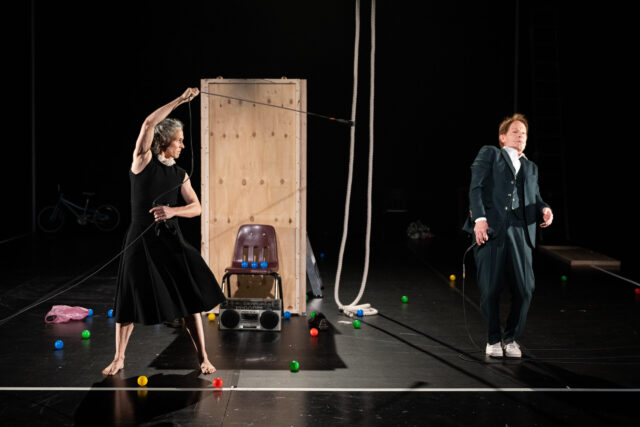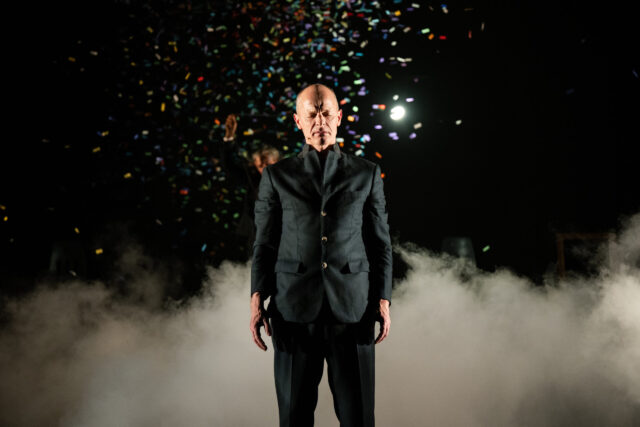
The Dancer (Rachel Poirier) whips the Dance Man (Michael Keegan-Dolan) into shape in semiautobiographical show (photo by Teddy Wolff)
HOW TO BE A DANCER IN 72,000 EASY LESSONS
St. Ann’s Warehouse
45 Water St.
Through November 5, $39-$69
718-254-8779
stannswarehouse.org
“Don’t look back,” Michael Keegan-Dolan says near the beginning of the exceptional How to Be a Dancer in 72,000 Easy Lessons. “But I want to look back.”
The Irish choreographer and director takes a unique look back in his triumphant return to the stage after two decades, joined by his longtime collaborator and life partner, French dancer Rachel Poirier. The semiautobiographical ninety-minute show — the first dance-theater work to be presented by St. Ann’s Warehouse — starts and ends with a story about an egg, signaling birth and rebirth. Keegan-Dolan is the Dance Man and Poirier the Dancer as he relates episodes from his past. Driven by his deep desire to be a dancer, he walked a long road to success with his pigeon-toed feet that included being bullied by other boys for dancing like a “queer” and a bruising stint in musical theater, among other adventures.

Michael Keegan-Dolan returns to the stage in How to Be a Dancer in 72,000 Easy Lessons at St. Ann’s (photo by Teddy Wolff)
The Dance Man prefers Gene Kelly to rugby, ballet to musical theater. Across forty-one brief scenes, the character introduces us to his mother and father, his best friend, his choir priest, his ballet teacher, his first girlfriend, Belgian choreographer Anne Teresa de Keersmaeker, his brother Paul, and a famous Australian conductor. He includes the high and low points, the moments that forged his future as he sought the freedom to be who he wanted to be, anchored by his meeting the Dancer, who moves about the stage and interacts with him in often outrageously funny and deliciously wicked ways as he shares his tales.
Each vignette features playful props that Keegan-Dolan and Poirier remove from a large wooden box and scatter about, from a child’s bicycle and a red balloon to a mirror and a helium tank, from cinderblocks and shoes to a dartboard and a ladder. A long white rope hangs down from the ceiling, offering danger and escape. White tape forms a large rectangle on the floor and back wall, but Keegan-Dolan, in a black suit and white shirt, and Poirier, in a black dress, ignore it, refusing to be contained.
The set and costumes are by Hyemi Shin, with lighting and direction by Adam Silverman and sound by Sandra Ní Mhathúna, creating an anything-goes atmosphere. Keegan-Dolan often carries a boombox with him, playing such songs as Jacques Brel’s “J’arrive,” Men Without Hats’ “The Safety Dance,” Depeche Mode’s “Just Can’t Get Enough,” Queen’s “Bohemian Rhapsody,” and Charles Penrose’s “The Laughing Policeman,” in addition to pieces by Stravinsky, Strauss, Handel, and Verdi.
“Psycho Killer,” with its touch of French, plays a pivotal role, as the Dance Man points out, “If there is a place in the world for the Talking Heads’ lead singer and front man David Byrne, then there must be a place in the world for me.” Poirier brings down the house with an exhilarating and exhausting fifteen-minute solo to Maurice Ravel’s “Bolero in C Major” that is breathlessly exquisite.
Nearly every minute provides something singular and unexpected, running the gamut of emotions, as exemplified when the Dance Man runs around the stage. “I have a voice!” he declares early on. “And it’s not, the endless monologue in my head, in my head voice. This is my voice.”
Keegan-Dolan found his voice through dance; his latest show, subtitled “A Performance Ritual in Four Parts for Two Performers,” is a clarion call for everyone to seek out and find theirs.
[Mark Rifkin is a Brooklyn-born, Manhattan-based writer and editor; you can follow him on Substack here.]